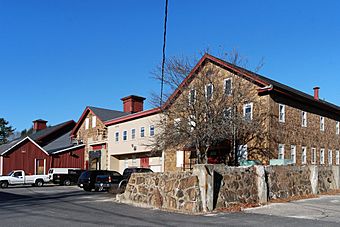Ames Shovel Shop facts for kids
Quick facts for kids |
|
|
Ames Shovel Shop
|
|
|
U.S. Historic district
Contributing property |
|

A view of the 1870 Store House (right) and 1852 Long Shop (center, with red cupola), from the southeast corner of the complex
|
|
| Location | Easton, Massachusetts |
|---|---|
| Part of | North Easton Historic District (ID72000119) |
| Added to NRHP | November 3, 1972 |
The Ames Shovel Shops are a group of historic factory buildings located in North Easton, Massachusetts. These buildings were built between 1852 and 1885. They are a key part of the North Easton Historic District.
The shops are also very close to the H. H. Richardson Historic District of North Easton. This area has many buildings designed by a famous architect named Henry Hobson Richardson. The Ames family, who owned the shovel company, asked him to design these buildings.
In 2009, the Ames Shovel Shops were listed as one of the 11 most endangered historic places in the United States. This was because there was a plan to turn the main part of the site into homes. However, later that year, a new plan was agreed upon. This plan allowed for less development and was supported by groups like the National Trust for Historic Preservation. Construction on the new plan began in 2012.
Contents
The History of Ames Shovels
The story of the Ames Shovel Company began in 1774. That's when Capt. John Ames started making iron shovels in West Bridgewater, Massachusetts. His son, Oliver Ames, Sr., moved the company to North Easton in 1803.
A Family Business Grows
In 1844, Oliver Ames, Sr. gave the shovel business to two of his sons, Oakes and Oliver, Jr.. The company then became known as Oliver Ames & Sons. Just a few years later, gold was discovered in California in 1848. Then, more gold was found in Australia in 1851. This created a huge demand for shovels all over the world! The Ames company was already known for making very good quality shovels.
Rebuilding and Expanding
In 1851, the original shovel factory was destroyed by a fire. But the company quickly rebuilt. By 1852, the first of the new shops was finished. The demand for shovels stayed strong. This was because of the rapid growth of railroads and, later, the American Civil War.
During the Civil War, Abraham Lincoln himself asked Oakes Ames to provide shovels for the Union Army. This made the Ames brothers very rich. The Ames brothers also became important in politics. They helped fund the building of the Union Pacific Railroad. They also helped develop the town of North Easton. The shovel factory kept growing until 1928.
Ames shovels became the standard shovels for the U.S. Army. Soldiers used them in every conflict from the American Civil War all the way to the Korean War. The Ames Shovel Company stopped making shovels in Easton in 1952.
The Shops Today
Since the 1950s, many different small businesses have used the old factory buildings. The Ames brand is now part of the Ames True Temper Company.
Redevelopment and New Uses
In 2009, there was a plan to change the main factory complex. Some old buildings might have been torn down to build new homes. This made groups like Preservation Massachusetts worried. They listed the site as one of the most endangered historic places in the state.
However, a part of the complex, the 1870 handle shop, is now used by the local YMCA. This part was not included in the redevelopment plans. The old Old Colony Railroad Station is right next to the shops. It was designed by Richardson and is now home to the Easton Historical Society.
Future Plans for the Area
The railroad tracks near the Shovel Shop are mostly abandoned. But there are plans to extend the MBTA commuter rail line. This would connect Stoughton to Fall River and New Bedford.
As of 2014, the Ames Shovel Shop site has been turned into apartment homes. The developers worked to keep the historic look of the buildings. There are signs around the area that tell the history of the different buildings. There are also many walking paths nearby.
The old railroad station might reopen as part of the South Coast Rail project. This project would allow commuters from New Bedford and Fall River to travel through Taunton to Stoughton station. From there, they could go to Back Bay station and South Station in Boston.







